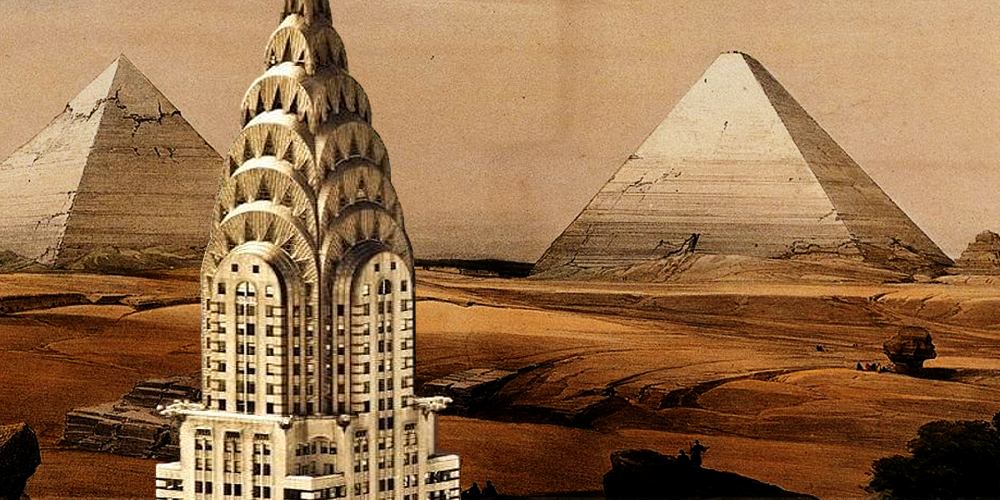
Phoenix Kaspian is an industrialist. He works in hydrogen-automotive manufacture and urban structures. Phoenix's early graphics work included a collaboration with Steve Jobs. Phoenix's book designs have been described by The New York Times as "fabulously surreal", "beautiful" and "stunningly imaginative". While Susan Orlean at The New Yorker called Phoenix's graphics work "amazing". As a journalist, Phoenix wrote for The Telegraph, and The Times in London. Today, Phoenix works for a manufacturing and visualization firm.
If you could somehow chop the top off several major New York City skyscrapers, and plant these tops in the desert, you would end up with a panorama that recalls a lost Egyptian or Inca civilization. For what really stands at the pinnacle of monuments like the Chrysler Building, the Empire State, and the General Electric building?
On closer inspection, all three (and more) of these skyscrapers are plinths soaring up to an ornate crescendo. Like curious flowers on unremarkable stems, the top-floors of these skyscrapers are the part that seems to have mattered most to the men that built them — the pharaohs of our age. There, higher than most will ever tread, sometimes peaking above the clouds of Manhattan, stand the Cloud Pyramids.
Most entrancing among the Cloud Pyramids is the top of the Chrysler Building, and its mysterious Cloud Club. Completed in 1930, this was an occult temple in the sky built by Walter P. Chrysler for the exclusive use of a select group of 300 hand-picked men who were given private access to three floors in the uppermost parts of the Chrysler building.
Now demolished, the Cloud Club was located at the hem of the stainless-steel tip of the Chrysler, spanning three floors; from floors 66 to 68. The Cloud Club included a shower room; a massage room, a bar; a 'Red Room'; a 'Blue Room'; a 'Yellow Lounge'; bathrooms, kitchens, a service elevator, several express-elevators, and numerous corridors and discrete spaces. The club also contained an oyster bar; eight private dining rooms; a 'coffee room', and a 'stock ticker' room.
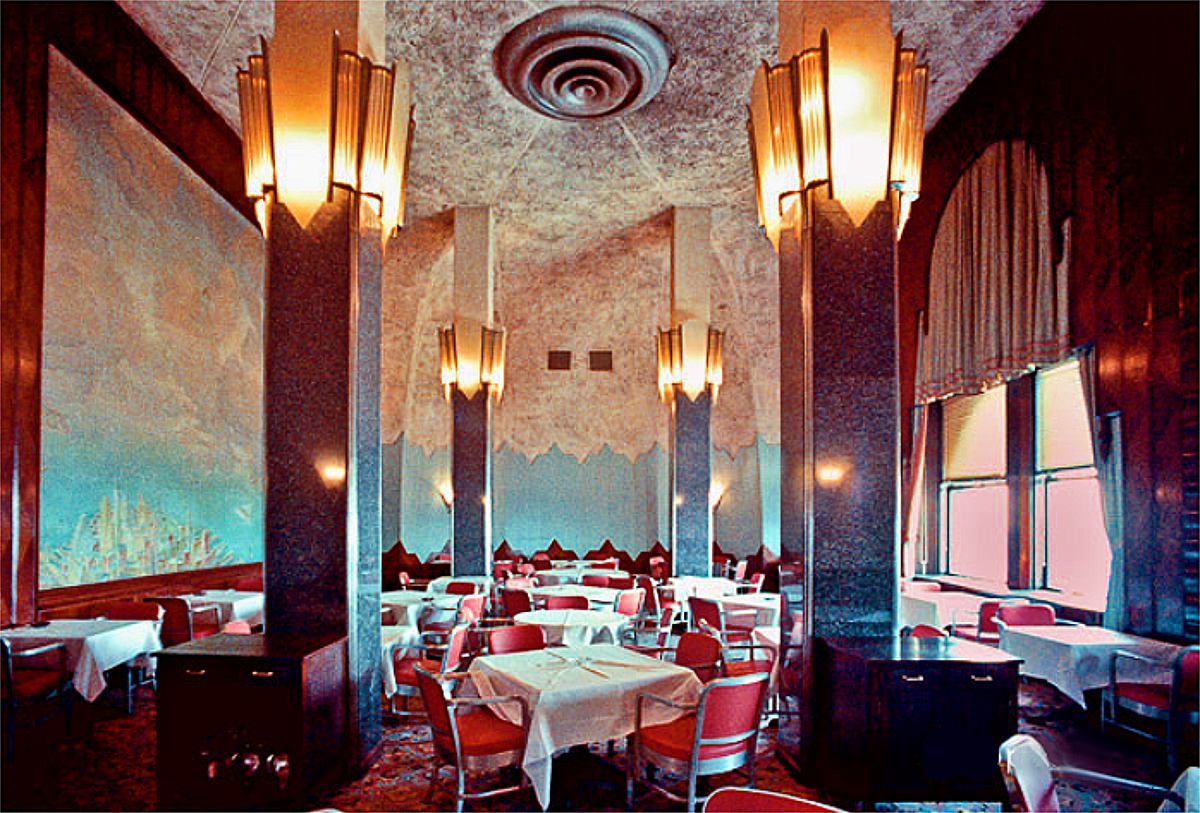
The Cloud Club, and the Chrysler Building itself, was constructed, throughout, in an architectural schema that let Cloud Club members know that they were free to practice a specific occult religion throughout the building. Here is a photograph of the lobby of the Cloud Club:
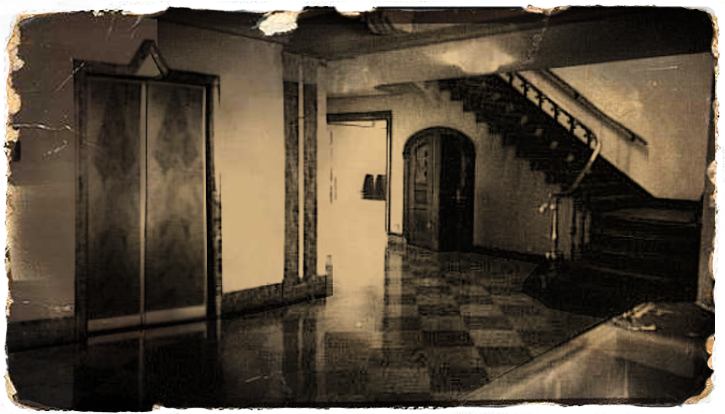
But before we get to the nature of this esoteric religion, and fully deconstruct the secrets of the Chrysler, it is important to understand why so many wealthy New Yorkers were building these Cloud Pyramids. What drove this cultural oddity?
Why did Walter Chrysler and other wealthy industrialists build towers that, at their highest points, look extraordinarily like Egyptian pyramids, or Incan temples? Why not invent a new style? Why not pay more attention to the middle floors? Why are so many skyscrapers of the era a grand lobby, followed by a bland middle, terminated by a quasi-Egyptian top? The answer to this riddle exposes a crime syndicate, wrapped in an occult religion, that operates until this day. It also reveals a hidden purpose to several buildings.
The popular explanation for New York City's numerous Cloud Pyramids explains this architecture away as the eccentric byproduct of a giant game of poker. New York City is presented by many historians as a giant poker table, onto which the Captains of Industry in the 1920s, and beyond, would fiercely push stacks of 'poker chips'. These were not literal poker-chips, but instead took the form of increasingly arrogant examples of architecture — stacks of bricks rather than living-spaces.
Some of these skyscrapers turned out passably, although nothing extraordinarily beautiful was ever going to result from the crude design-brief of "make my tower taller than any other". Hence, New York, from afar, looks like a stacked poker table. The men who ordered swathes of the city to be built wrote their subconscious motives across its skyline. They sought to endlessly raise-the-stakes on each other's architecture in those inglorious moments leading up to the Great Depression, when the house took all.
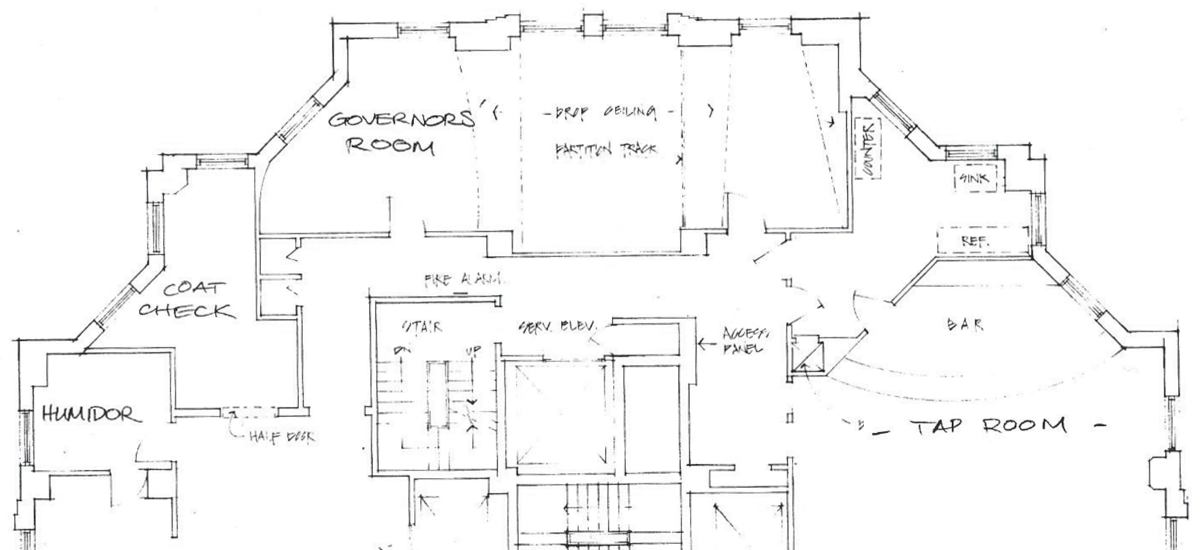
The story goes that Walter P. Chrysler, of the eponymous Chrysler Building, began to push his stack of poker-chips onto the felt of Manhattan's poker table in January of 1929, determined to emasculate all those surrounding him. So determined was Walter (and we will use his first name to differentiate him from his tower) to raise-the-stakes on his skyscraper-'poker'-buddies that, by October of 1929, the Chrysler building was the world's tallest structure.
The Cloud Club was included in the building's original architectural plans. The New York Times later reported that the Cloud Club was crammed with:
"...kitchens, a stock-ticker room, a humidor, a barber shop and a locker room with cabinets for stashing one's booze during Prohibition.... Backstage, the Cloud Club must have felt like a submarine — or, rather, like a very cramped airship."Walter soon learned that another building, 40 Wall St, might surpass his new tower, and so demanded that a 125-foot-long 'bonus' spire was secretly manufactured within the Chrysler, then whipped-out and fastened to the top of the building at the last moment, making Walter, definitively, the tallest man in New York. But this game was doomed: The Empire State swiftly copied Walter's trick and regained the crown.
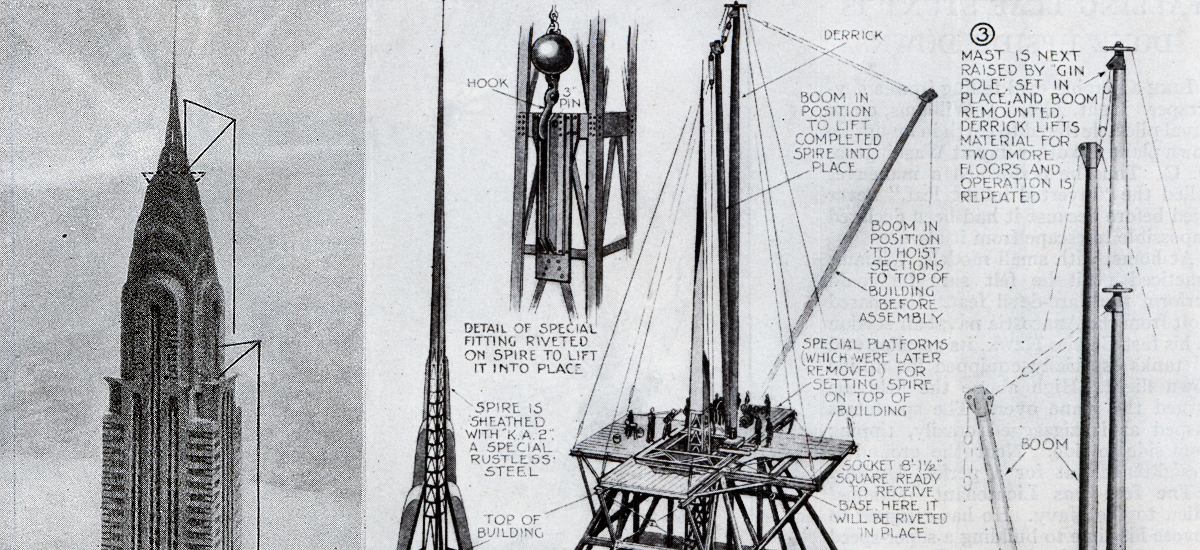
But what if these men were not entirely engaged in a game of bizarre one-upmanship? What if some of these captains of industry, in fact, belonged to the same club? What if membership of this club was precisely the reason why they were captains of industry? Naturally, the reader will feel some resistance to this idea: It suggests that a great trick has been played on our culture. It is strange enough to be excluded from a club that you know of; even stranger to be excluded from an occult, or 'secret', one.
Encoded within the architectural motifs of several major New York skyscrapers, including the Chrysler Building, is a pseudo-hieroglyphic vocabulary of symbols which refer back to the initiatory diagrams of Freemasonic rites and rituals. The challenge in reading and interpreting these architectural hieroglyphs is not an academic one: the truth is plain to see once the 'decryption key' is known. What is difficult is accepting the implications of this new understanding.
Walter Chrysler openly identified as a Freemason, and his allegiance to the group is not in dispute. Walter was a Royalist, descendant of an elite German family considered to be 'first stock American'. Many of Walter's automobiles bore the symbols of the crown, and were called names like the 'Chrysler Crown Imperial', the 'Chrysler Windsor', and the 'Chrysler Royal'. Walter said that he could not recall his relatives specifically "I got millions of 'em," he would deflect. But the truth was that Walter's family had changed their German name, from Kreißler (meaning 'tear' or 'crack' in German) to the 'Americanized' Chrysler.
While some historians have painted Walter as one of the great American entrepreneurs, in fact he promoted Anglo-German monarchistic rule. Walter practiced the occult religion of Freemasonry, the same ideological system that underpins the European Royal Families. In other words: Walter could hardly have been less aligned with the American Constitution. Walter represented the interests of the same elite group that Americans had fought off during the War of Independence. Instead of being expunged from America, the Anglo-German aristocracy effectively sneaked its way back into power, only this time their emissaries spoke with American accents and claimed to be 'entrepreneurs'.
Walter famously exhibited, inside a glass box, on the observation deck of the Chrysler Building, his original 'handmade toolkit'. Visitors could peer at it in wonder. This surprisingly unweathered wooden-box of dividers and rulers hinted modestly at Walter's working-class, rags-to-riches story. It was an endearing story of the sort that only the unjustly-privileged feel inclined to remind the public of at every given opportunity.
In deciphering the Chrysler Building, we are tasked with conclusively proving that the building is an occult-Freemasonic temple. Some of the symbols in the building occur in buildings elsewhere, but it is the dense constellation of these hieroglyphs, and the context in which they are used in the Chrysler, that unmistakably betrays the secret purpose of the building.
There is also the mystery of the Cloud Club's color-themed rooms. The Freemasonic significance of these colors goes beyond the scope of this article. For brevity, it is sufficient to know that the Cloud Club contained, among other rooms, a 'Blue Room' (66th floor); a 'Yellow/Gold Lounge' (66th Floor); and a Red Room (67th Floor). These colors represent both degrees (hierarchy) within Freemasonry, but also differences between branches of Freemasonry.
The color of a room is also known to connote the different occult rituals that must be performed in each room in order for a Freemason to 'advance' through the 'ranks'. Additionally, the color red is associated with the 'Royal Arch Chapter' Freemasons, while blue is associated with so-called 'Craft' Freemasons. However, these colors can also denote a hierarchy within a single sect of the group. Therefore they are confusing to everyone; by design.
The tactical purpose of these colored rooms in Freemasonic architecture has been deeply explored elsewhere, so that ground will not be covered here. Some readers will recognize the Cloud Club's system of colored-rooms is used in Stanley Kubricks movie The Shining (1980), during which the character Danny references 'redrum' (red room). Kubrick made this choice for good reason. Other readers will be familiar with the concept of a 'code red' from the movie A Few Good Men (1992). Urban folklore surrounding 'red rooms' also hints at our culture's intuitively uneasy feeling about this concept.
In Charlotte Bronte’s novel Jane Eyre, Jane (a child) is locked into "The Red Room" as 'punishment':
“The red-room was a square chamber... The carpet was red… the walls were hung with red... I was oppressed, suffocated: endurance broke down; I rushed to the door and shook the lock in desperate effort."Bronte decribes this child's experience as she is tortured in the Red Room. Jane is told she will be released from the Red Room, Bronte writes:
"only on condition of perfect submission and stillness... an all-predominating sense of terror."Next, Jane is thrown across the Red Room and loses consciousness; the child cannot say what else occurs. Readers of Bronte's book will also recall that, trapped in the attic, at the highest-point of Thornfield Manor (closest to the clouds, we could say), lives the “Madwoman in the Attic”, Bertha Mason.
Freemasonry has reportedly existed since around the year 1200 and Jane Eyre was published in the year 1847. Below are two photographs of Walter Chrysler's Red Room in the Cloud Club; built for the private use of himself and a subset of the club's 300 male-only members. These photographs were taken after the club was allegedly closed (1979) so, while the room color; carpet and wall-frieze is unchanged, it is unclear what furniture was in the Red Room during Walter's occupancy:
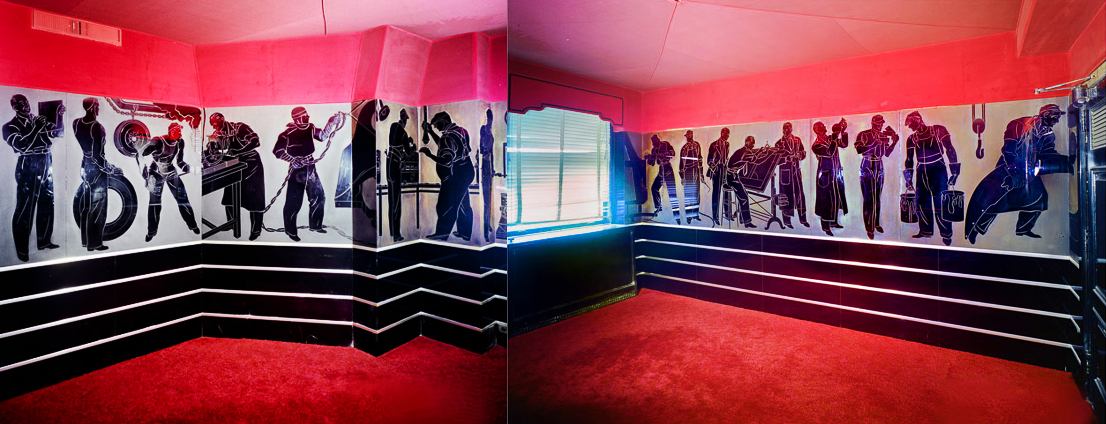
To understand the symbol system hidden within the Chrysler, we must first familiarize ourselves with the general architectural 'vocabulary' of the Freemasons. Although the Chrysler building obfuscates these primary symbols, it is from the basic 'words' of Freemasonic iconography that the Chrysler derives its 'phrases'. Indeed, it is with linguistics that we can draw a useful analogy: The Chrysler building is a cipher; a codex; an 'encrypted' message to so-called high-ranking Freemasons. It celebrates a 'secret society' that advances neo-Aztec mythologies of hierarchy, domination and sacrifice.
In understanding how architecture can encrypt messages, we can consider 'braile', which is a three-dimensional code of physical undulations on paper, felt by the fingertips of a blind person. To the untrained eye, braille is unremarkable; invisible even.
Messages in braille could be turned into a wallpaper in a hotel room, or a pattern on the surface of a building's lobby. Only those trained in reading braille would be able to interpret the message. However — and more importantly — only those trained in reading braille may even know the message was there to begin with. This is the critical issue with Freemasonic cryptography: most of us cannot read it, because we are not taught that it is even there. This is the case with the Chrysler building: Once we are aware a message exists, for example in the architectural motifs in the Chrysler building's lobby (pictured below, right), the message can be decoded:
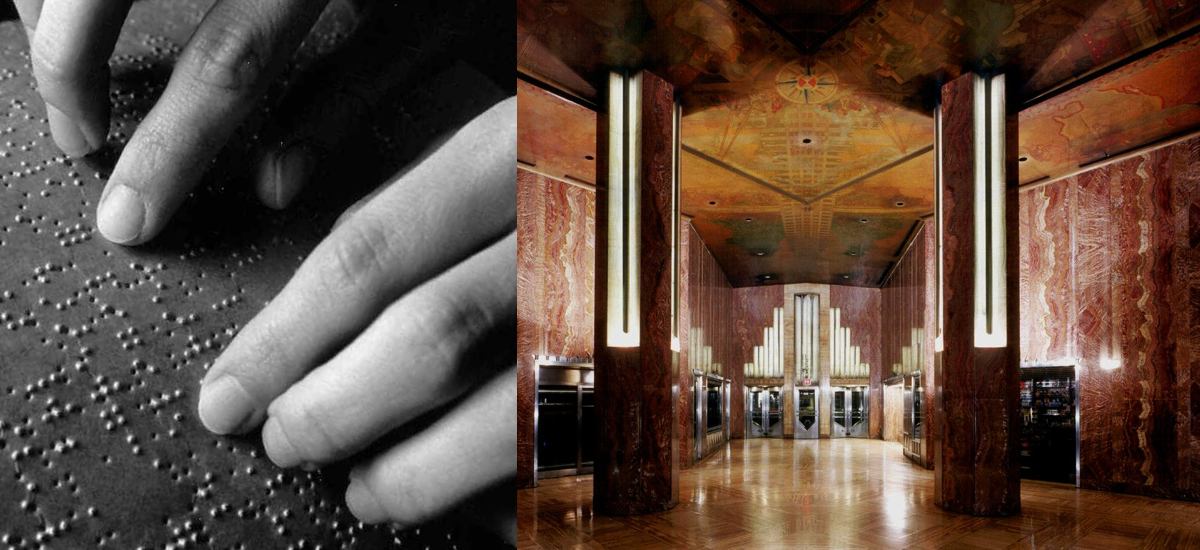
The Freemasonic cipher system uses, generally, a basic 'substitution' cipher. This is a crude cipher (or encryption method) in which a known set of graphical-symbols are 'substituted' or 'disguised' by using a novel set of symbols. In other words, looking at the lobby of the Chrysler, you probably see two randomly placed columns, a meaningless ceiling pattern, and some art-deco lights. However, an initiated Freemason can see that the lobby depicts primary Freemasonic imagery:
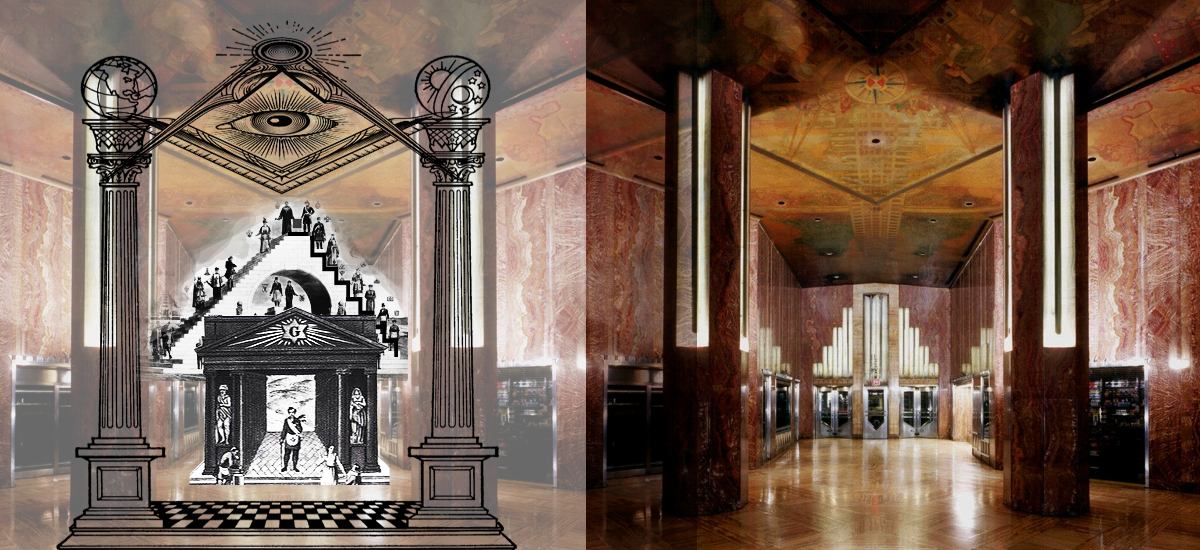
This is only an initial glimpse of the Freemasonic code hidden in the Chrysler building's architecture; the building is brimming with occult iconography. The alleged meaning of these symbols to the Freemason cult is beyond the scope of this article, and it is all inconsistent nonsense anyway; designed merely to beguile and bewilder the Freemasonic initiate as they are slowly brainwashed into believing some great mystery will eventually be revealed to them.
For brevity, the reader can see that the Chrysler lobby contains allusions to the commonly-depicted Freemasonic pillars. Then, at the back of the lobby, we see the placement of a 'temple' entrance which is typical of many (but not all) classic initiatory Freemasonic diagrams. Additionally, the lights at the rear of the lobby are an allusion to the Freemasonic 'degree' system, also depicted as a staricase, ascending pathway, or steps in numerous classical texts and diagrams.
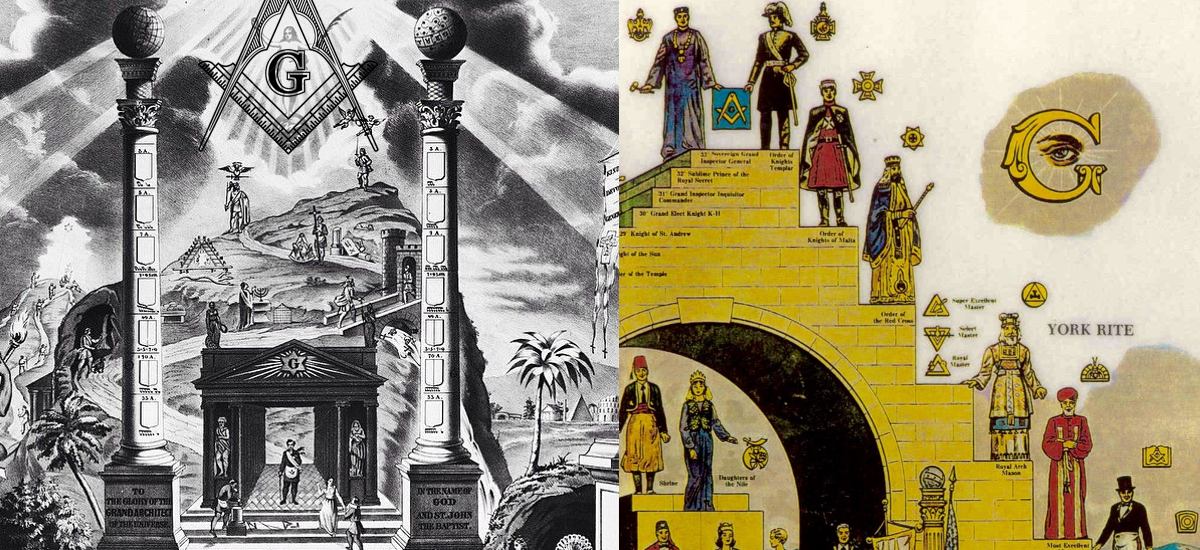
In the lobby of the Chrysler Building, we can also see the inevitable allusion to the primary Freemasonic logo; the dividers and ruler, placed at the top of the motif. In the Chrysler lobby, this symbol is viewed in perspective, and the 'all seeing' eye is merely hinted at by a single point. This simplified-notation is commonly used by Freemasons when their gang-sign is shown in its obfuscated form, for example in the Ahwahnee Hotel in Yosemite Park. Of course, the cynic can write-off the architecture of the Chrysler's lobby as odd coincidence. But, as we continue to dissect the Chrysler building, these 'coincidences' become constellations of meaning that cannot be ignored.
Fortunately, several 'Rosetta Stones' exist for interpreting the language of the Freemasons. Here, for example, is the inside of a known Freemasonic temple. This image is only publicly available because the temple in which it was located was vacant, and put on the open-market by a realtor. Pay particular attention to the symbols on the floor of the temple:
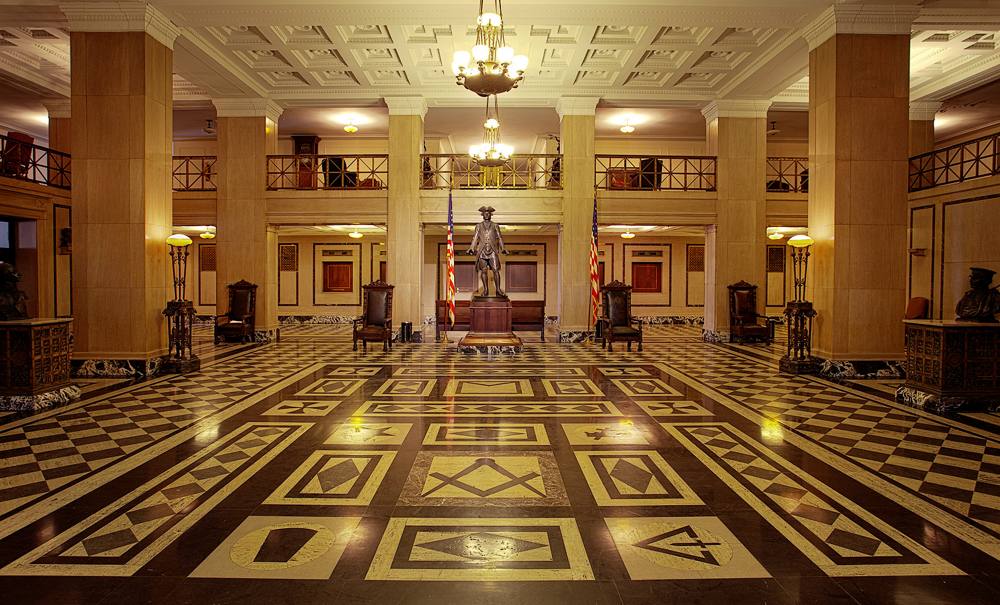
As with the Rosetta stone, we can intuit a parallel translation of 'words' that have the same meaning. On the floor of this temple, the Freemasons' gang-signs are shown in both their complex and simplified forms. For brevity, the reader will have to do their own research to establish the recurrence of these symbols in multiple Freemason temples, but you will find that they are used consistently by different Freemasonic groups. The key symbols for the reader to grasp, in order to broadly interpret the Chrysler building, are those simplified variations on the Freemasonic 'logo' of the 'square' and 'compass'.
As you can see from the 'Rosetta stone' of this Freemasonic temple floor, the Freemason's main logo can be abbreviated as a diamond-shape. There are simple, black dimonds enscribed on both-sides of the compass and square.
Demonstrating the common procurance of diamond-shapes in Freemasonic temples, and on Freemason-controlled businesses, is an exercise for the reader. The symbol is extremely common. Although various esoteric-explanations are given to initiates for this motif, the Freemasons 'logo' means 'divide and rule'. This 'dividing and ruling' refers both to what Freemasons do to our culture, but also what the high-ranking Freemasons do to the 'lower' ranking ones, and to children.
The Freemasonic Ponzi Club: Most Freemasons think they are being given occult knowledge and power. In fact, they are being initiated into a giant ponzi scheme. In return for providing the 'higher' Freemasons with 'kompromat' (self-incriminating blackmail material) the initiate is advanced up the 'degrees' of the Freemasonic hierarchy. As a Freemason attains more 'power' they are installed in 'higher' positions of authority by those at the top of the ranks. At the top of the Freemasonic system is the British Royal Family and other genocidal, colonialist superstructures. It is for this reason that many court judges, politicians, business 'leaders', and police officers are Freemasons.
The more corrupt a person is — and the more evidence of that corruption the Freemasons gather — the more that person can be controlled. When sufficient 'kompromat' has been gathered, the Freemasons feel comfortable using that 'initiate' as a 'puppet' in a position of 'power'.
It is important to be aware of a vital defense system operating within the Freemasonic cults: Initiates are, at the lowest 'degrees' divided into two groups. This division is not revealed to the initiate. An honest, ethical person who joins the Freemasons will only be allowed access to the 'Boy Scouts' level of the group. Such a person may believe they are advancing through the ranks, but the true purpose of the Freemasons is never revealed to them. Such a person unknowingly provides 'cover' or 'flak' for the Freemasons. They form an outer group of naive fools who do not realize they are participating in a great crime. This naive group of people creates an illusion of normalcy and a layer of protection for the inner-circle of Freemasons. It is often these Freemason cult-members who will most-convincingly protest any critique of the Freemasons. They are not aware of the true purpose of the group and so serve its interests blindly.
Freemasons are divided against each other by 'degree', both formally and secretly. 'Higher' degree Freemasons are taught psychological tricks to divide non-Freemasons against each other. However, it is ultimately stupid that these Freemason-initiates assume that the 'Masters' who are teaching them to abuse and trick society are not tricking the Freemasonic initiates also. Hence, the Freemasons is primarily a cult for stupid people. Nevertheless, it is still extremely dangerous. You can listen to one survivor's account of being taken to rituals as a child, here.
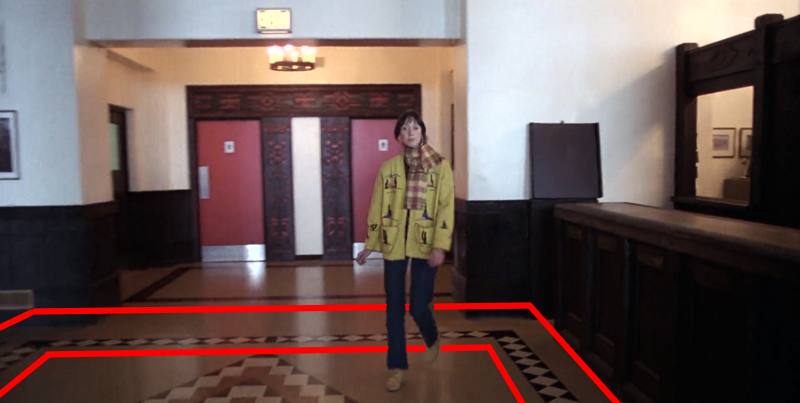
This diamond pattern is often tessellated-out into the familiar 'checkerboard' or 'chessboard' pattern of the Freemasons' ritual rooms. This type of checkerboard is seen in almost every known Freemasonic temple, across the world. Here, we can see it on the floor at the main entrance to the Cloud Club:

Why do Freemasonic temples invariably include a checkerboard floor? Although naieve initiates are given various esoteric explanations for this pattern being present, the real purpose is simple. Adults, and children, are abused on the floors of these Freemason temple rooms and, in basic accordance with Pavlovian associative-conditioning, pain and fear is traumatically associated with the visual-stimulus of the checkerboard pattern. This pattern occurs repeatedly in the Chrysler Building, across different floors. However, when I contacted Anthony Robins, Vice President of The Art Deco Society of New York he was unable to determine for me the location of these floors in the Chrysler building:
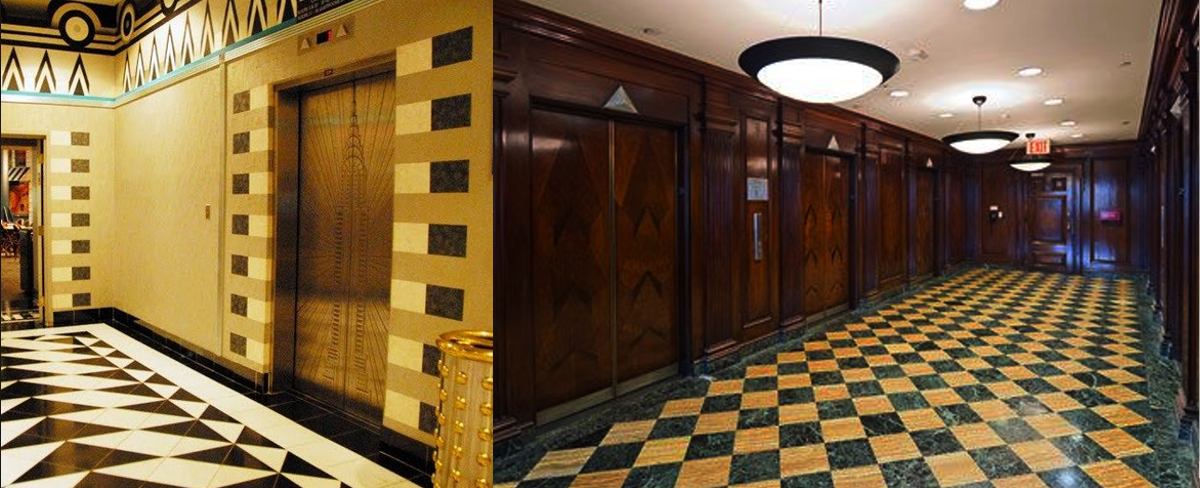
Just as Pavlov trained his dogs to salivate when a bell rang; the Freemasons 'train' children to enter states of traumatic-paralysis when they see a checkerboard pattern. This is one reason why many of us fear police vehicles: Some 'police' groups use Freemasonic symbol sets to terrorize the citizenry. The checkerboard pattern on the British police uniforms, for example, is derived directly from the Masonic ritual-symbol. This pattern, known as Sillitoe Tartan, was first introduced to the British police force in 1932 by a Freemason, Sir Percy Sillitoe, who was Chief Constable of the City of Glasgow Police (pictured below, left).

Percy Sillitoe was was inducted into the Freemasons at the Scarsdale Freemasons Lodge in December 1923, nine years later he introduced the checkerboard to the police uniform; wrapped around the heads of 'police' officers. Sillitoe went on to be appointed as Director General of MI5; the 'spy' agency.
Once a motif is subconsciously-associated with pain, the motif alone can be used to induce a panic-state. It is unknown how many children the Freemasons have abused, but it is substantial. You can listen to a survivor's account of Freemasonic rituals here
Before we examine more architectural detail in the Chrysler Building, I feel obliged to mention my encounters with those people who were the final occupants of the floors directly above and below the Cloud Club prior to its demolition. These encounters were, in themselves, mysterious and, some might say, suspicious.
I contacted New York photographer, Andrew Bordwin who took the last known photographs of the Cloud Club. Despite initially expressing confusion about what possible relationship the Chrysler building might have to Freemasonry or the abuse of children, Bordwin, in a later email, asked me if I had watched a film called Cremaster III which he described as, "Just a curiosity.". This movie turned out to depict a brutal re-enactment of various Freemasonic rituals (some involving children). Throughout the movie, the Freemasons display their logos and costumes openly.
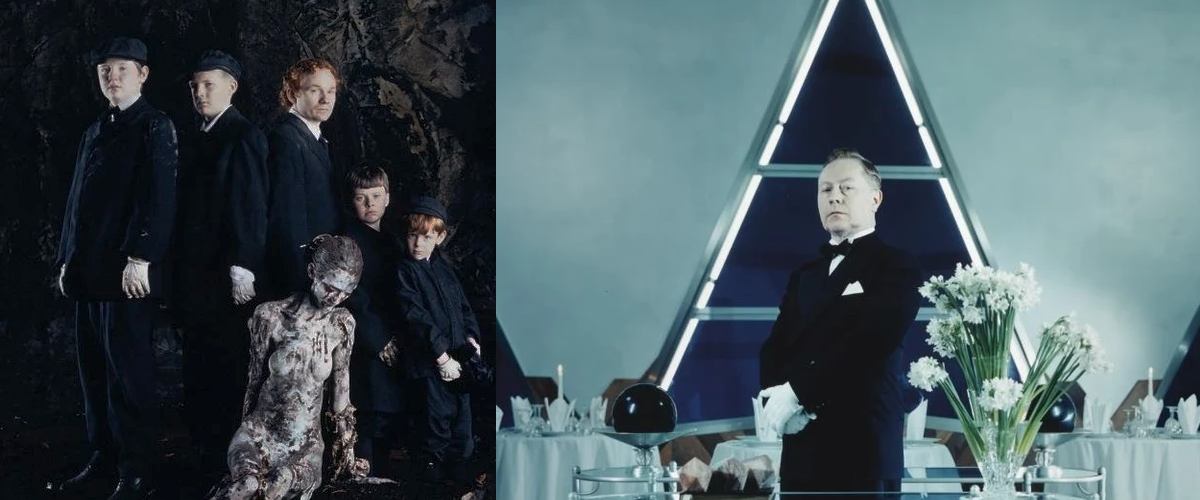
In Cremaster III, a man visits the Freemasonic temple in the Cloud Club, betrays the Freemasons, has his teeth smashed in, and is dragged to the top of the Chrysler building to be tortured. Here, the snitch is strapped to a dentist's chair and has his gentitals ripped out by Master Masons in a horrifically graphic scene.
I found it intriguing that Bordwin had suggested I watch this cautionary tale ("Just a curiosity."), especially since he initially knew nothing about the Freemasons. Was he trying to communicate something with me?
As a journalist, I had often been threatened, sometimes been assaulted, but this high-budget motion picture far exceeded the most lavish attempts to silence me in the past. The Freemasons are the first group I've encountered who are so used to threatening people that they have made an entire instructional-movie about it. Presumably this is easier than going through the mundane rigmarole of heavy breathing down a phone at 3am. The Freemasons don't often like to make their messages clear, but Bordwin's movie-recommendation contained a message that was plain as day: We will smash out your teeth and rip your genitals off if you expose us.
As a teenager, I watched numerous horror movies, but I have to concede that Cremaster III is one of the most disgusting things I have ever seen. The movie begins with the Freemasonic logo and shows children bringing a corpse into the lobby of the Chrysler building. The children put this corpse into a car, a Chrysler 'New Yorker' model. This 'New Yorker' car is then rammed to pieces by three 'Chrysler Crown Imperial' cars. Do you get the symbolism? The Royal Freemasons (represented by the 'Crown Imperial' cars) are smashing New York society (represented by the 'New Yorker' car) to bits and using children in their sick rituals. Sophisticated movie, isn't it? The New York Times thought so; Yale graduate, and film critic, Stephen Holden, called Cremaster III "deliriously esoteric" and "thrilling" in his 2002 review.
After I had made it clear to Bordwin that my motive was the protection of children, Bordwin informed me that I could not buy a license to use his photos of the Cloud Club, nor could I even see thumbnails of them. It was, however, important to Bordwin that I should know he definitely had the photographs he was withholding. Here is one of Bordwin's photographs of the Cloud Club, which I managed to obtain by other means:
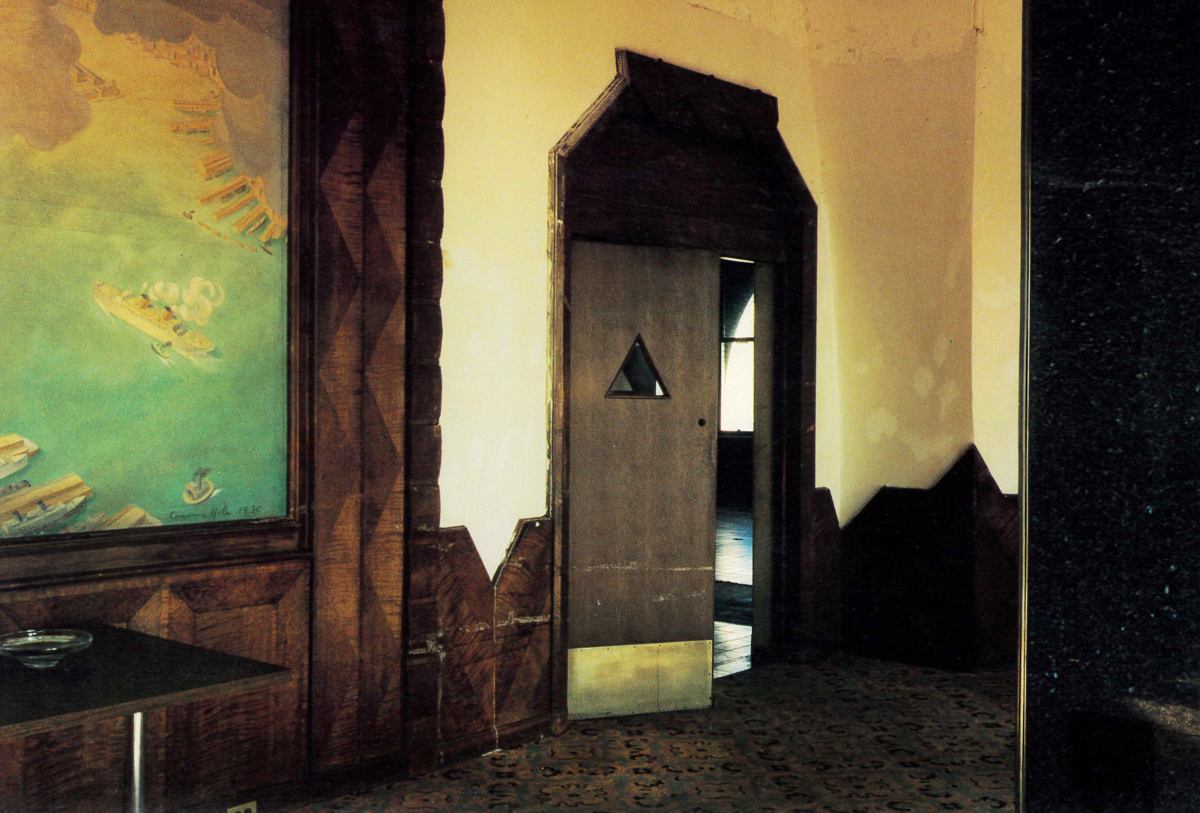
"I do indeed have what is likely the last photographic record of the Cloud Club," Bordwin wrote triumphantly in his final email. But I was not permitted to see it.
I decided to contact the two co-sponsors of Andrew Bordwin's public exhibition of the photographs, which opened on the 4th of September, 1991, at Gallery III at The Urban Center in New York City (6-8pm). Perhaps the sponsors of Bordwin's exhibition would know more. The first sponsor was a company called Cowperwood, which occupied the 71st floor of the Chrysler Building, just above the Cloud Club, from 1985 to 2005. Cowperwood is a subcontractor for the FBI.
I spoke with Edward Sussi, Executive Vice President at Cowperwood, one of the exhibitions co-sponsors. Sussi exchanged over 30 emails with me on various aspects of the Chrysler building. In these thirty emails, Sussi failed to mention, even once, that his company had paid at least $5,000 to sponsor Bordwin's Cloud Club photography exhibition. In fact, Sussi did not mention the photography exhibition at all. I chose not to inform Sussi of my knowledge of Bordwin's photography exhibition to see if Sussi's natural skills of recollection would emerge. They did not. Sussi had apparently forgotten his company's connection with Andrew Bordwin, or did not think it important enough to mention when I specifically, and repeatably, asked about photographs of the club.
Sussi gave me some details about the Cloud Club, but simultaneously claimed that a New York Times article must have got it wrong regarding various rooms. "I don’t recall seeing a bar or stage. Not sure there were showers either or that The NY Times article information was accurate," Sussi wrote.
Sussi claimed that he was not aware of activity on the Cloud Club floors during Cowperwood's twenty years of occupancy (71st Floor, 1985-2005), yet Anthony Robins, Vice-President of The Art Deco Society of New York told me that events were often held on those floors, some of which Robins personally attended. The Art Deco Society of New York, for example, used the Cloud Club for one of its first events in the early 1980s, and then again in the 1990s. Robins recalls that, this second time, the club was rented by Cooper-Hewitt, "as the perfect location for an illustrated lecture on the history of the World’s Tallest Buildings.”
Edward Sussi is a subcontractor for the FBI, servicing scores of FBI encampments. Sussi's work includes 'servicing' at least three FBI properties including, The J. Gordon Shanklin Building, Dallas; The McAllen Resident Agency, Texas; and the El Paso Federal Justice Center.
Readers may recall that the FBI helped run Jeffrey Epstein's child-rape island. The FBI also continue to withhold the names of those people who abused children at this location. The reader can do their own research into the enduring connection between the FBI and pedophilia. This is not to say that Edward Sussi is wrapped up in any of this. Just because a person works for known pedophiles, and supplies them, and held offices in the top of the Chrysler building for twenty years, it doesn't mean they are complicit. Does it? I keep forgetting whether the Nuremberg Defense was legally valid.
I contacted, Roya Moghadassi, the widow of Dr. Charles M. Weiss, the long-dead dentist whose chair was used in Cremaster III for the shots where the Freemasons mutilate their betrayer. The New York Times reported that this dentist had a large scrapbook containing photographs of the Cloud Club. Did Roya Moghadassi know where Dr. Weiss' scrapbook for the Cloud Club was? Had she ever been in the club?
"I have no access to the scrap book and I did not see the Club. Maybe Tishman, the building management would be able to help you," was Moghadassi's response. It was unclear why the building management company would have kept her husband's scrapbook from 2012 (when he died).
It was also strange that Moghadassi had never seen the Cloud Club, as her husband was infatuated with it, and prone to giving impromtu tours of the club. The New York Times discovered this when their reporter William L. Hamilton visited Dr. Weiss's skyscraper-dentist-chair in 2005. Dr Weiss told the New York Times that he had lunched at the Cloud Club in the 60s and 70s, before the club was allegedly — but apparently not literally — closed.
Finally, I discovered that the other major co-sponsor of the photography exhibition was now dead, but prior to his death seemed to have an extraordinary habit of turning up at exclusive events on checkerboard floors in connection with a group called "The Golden Fleece" which is, you've guessed it, a Freemasonic order.
My thesis was hardly disproved. In my efforts to clear up the mystery of the Cloud Club, a brief investigation turned up:
Curiouser and curiouser. Here's another picture of the derelict Cloud Club which photographer Andrew Bordwin sought to conceal. Again, I had to obtain it from another source:
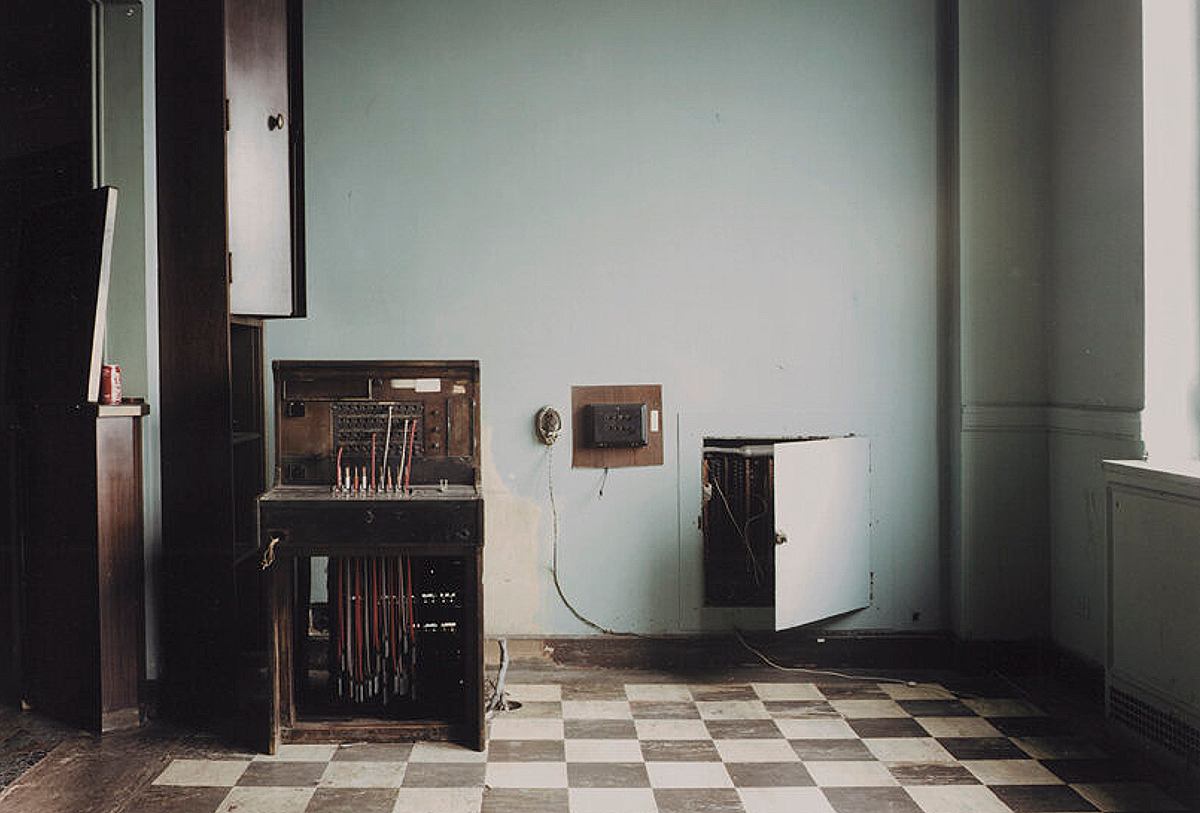
Freemasons reading this article are probably now too distracted by thinking up elaborate ways to torture and kill me, but for the casual reader, we'll return to the matter of the symbols used by Freemasons to mark their territory, and how these apply to the Chrysler building.
Spotting Freemason gang-signs: The checkerboard and diamond are just two symbols in the Freemasonic lexicon, and must appear in concert with other signs to strongly indicate Freemasonic gang-control of an area or property. Specifically, these additional symbols include: Crossed-out patterns; black-and-white patterns in general; the number 33 and its mathematical-factors; the use of 'green', 'blue' and 'red' descriptors especially when applied to rooms; specific arrangements of pillars; the eye-in-the-pyramid symbol; a square rotated 45-degrees across another square; octagons, triangles, pyramids and numerous others, alone or in combination.
Some of these symbols may seem ridiculous to you, even implausible, and indeed they are. Some have been willfully ridiculed in movies and cartoons to throw you off the scent. Some are used 'jokingly' by those who have no ill-intent or knowledge of their meaning to the Freemasons. Many of these symbols seem absurd simply because the Freemasons are absurd. They are a boys-club gone wrong. A hideous mess of superstition and nonsense, underwritten by violence against children.
The most difficult challenge in recognizing how symbols can be used to mark Freemason-territory is acknowledging just how much territory this cult has marked, and what this means for the welfare of children.
The Freemasonic cult's game is simply, "I am more powerful than you". Without the grand architectural trappings that proclaim their 'superiority' the game loses its purpose. Its purpose was, of course, to shield the Freemason against a horrendous tidal-wave: their inner feelings of inferiority. This inferiority is felt by the Freemason, typically because these men were themselves abused as children by the same occult group that, as adults, they work for.
Sadly, the architectural hieroglyphs of the Chrysler building could be more accurately viewed as a form of 'territorial pissing' akin to the activities of pack animals like wolves. Any artistry these buildings appears to have has been hijacked from those architects who were not fully aware of the hidden purpose of these structures. The motifs enscribed and encoded in buildings like the Chrysler do not elevate humanity, but instead reveal an occult network in which the abuse of children was routine, and the manipulation of humanity was the objective.
It is said that Walter Chrysler built the tallest bathroom in the world in the Chrysler building. This was so that Walter could look down at New York, perhaps imagining, from atop his tower, that he was pissing all over Manhattan. In a way, he was. Walter Chrysler was pissing on New York society; American Society; and, indeed, all of civilization who believes that equality, freedom and the rights of children are our core values.
Should the Chrysler building be demolished? No, that would mean erasing evidence of the crimes of those who built it. Instead, a museum to the children who were harmed should be constructed inside, and the land it stands on returned to the people of New York.
Even the most cynical reader, who cannot believe the Freemasons' crimes, must be concerned that the Art Deco Society of New York has no clear idea of what is inside the Chrysler Building (entire floors could not be identified). It is also concerning that a movie exists in which children are depicted participating in Freemasonic ritual murders in the Chrysler. There is also the fact that that apparently everyone who occupied the floors adjacent to the Cloud Club, prior to its demolition, is either dead or obstructive.
The New York 'elite' hid Manhattan resident, Jeffrey Epstein's rape of children for decades, and 'Iconic' ghouls like Woody Allen still prowl around the metropolis unchallenged. Covering-up child-abuse is a family-tradition for many wealthy Manhattanites. Of course, this is a tradition they have inherited from their British paymasters. New York is called the Empire State for a reason: The Anglo-German monarchic-empire and their stooges have yet to be kicked out. Perhaps this article will inspire some (metaphorical) kicking.
This article has only given the reader a tiny glimpse of what lurks inside the architecture of the Chrysler building, and a forthcoming documentary film on the topic will decode the entire structure. For now, the reader is invited to apply what has been learned and to interpret buildings in their local area. In particular, good-hearted New Yorkers (and I know that there are many of you), may want to take a detailed-look at Manhattan's other skyscrapers and determine which of these buildings also deserve some serious, and urgent, investigation. Good luck.